Abstract
BACKGROUND--Microbial corneal infection is the most serious complication of contact lens wear. Contact lens cases are a recognised potential source of pathogens associated with corneal ulcers. METHODS--This survey established the incidence of protozoal, bacterial, and fungal contact lens case contamination in 101 asymptomatic daily wear cosmetic contact lens wearers from a domiciliary contact lens practice. RESULTS--Eighty two (81%) contact lens cases were found to be contaminated, with 19 (19%) sterile. Of all contact lens cases, 78 (77%) grew bacteria, 24 (24%) fungi, and 20 (20%) protozoa. Acanthamoeba spp were isolated from eight (8%) contact lens cases. Fifty six (55%) contact lens cases yielded mixed bacterial contamination. This is the first contact lens case survey in which hydrogen peroxide disinfection was the major method of contact lens disinfection (75% of subjects) and no home made saline was used. All the contaminating organisms were shown to possess the enzyme catalase that breaks down hydrogen peroxide to oxygen and water. The polymicrobial nature of the biofilms found in many contact lens cases is illustrated electron micrographically. CONCLUSION--Based on data from this and previous studies, the authors conclude with recommendations for contact lens wearers: (1) regular scrubbing of contact lens case interior to disrupt biofilms; (2) exposure of contact lens case to very hot water (> or = 70 degrees C) will kill Acanthamoeba contaminants; (3) allow contact lens case to air dry between uses; (4) if hydrogen peroxide disinfection is preferred, use a two step system; (5) replace contact lens case regularly.
Full text
PDF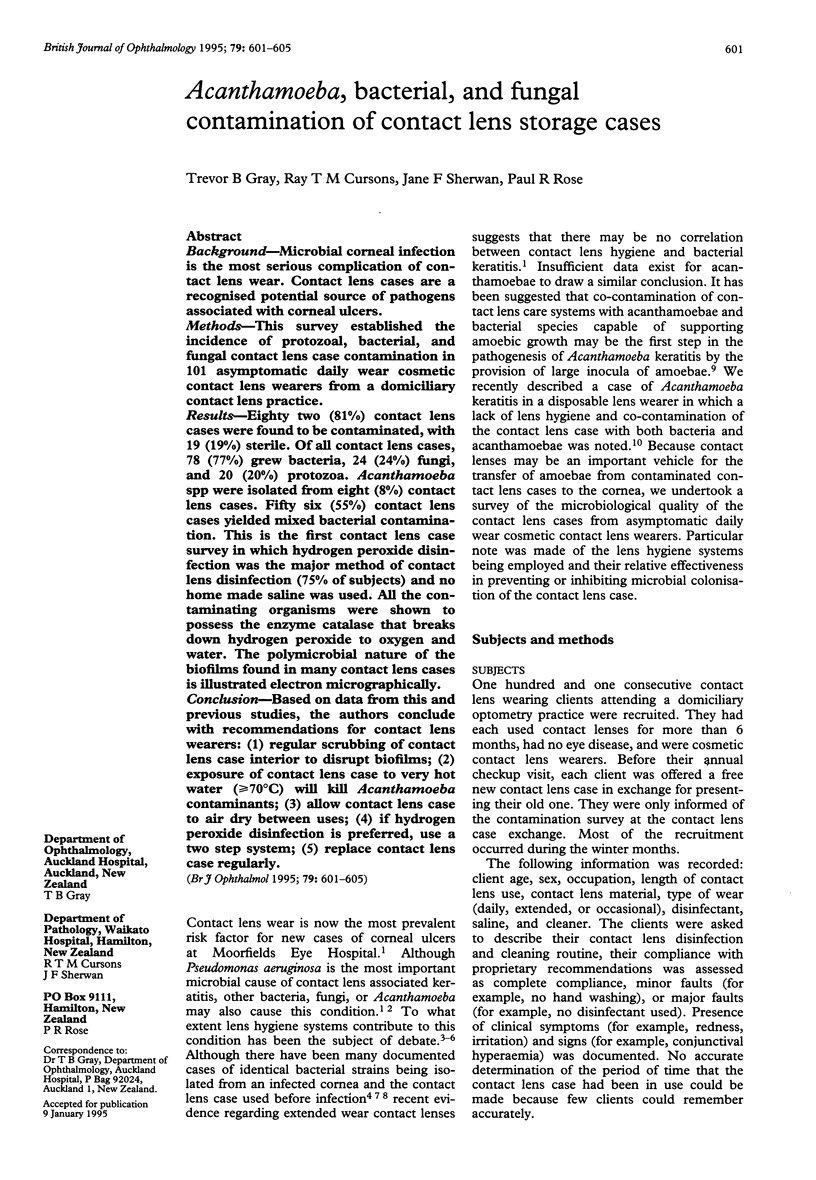
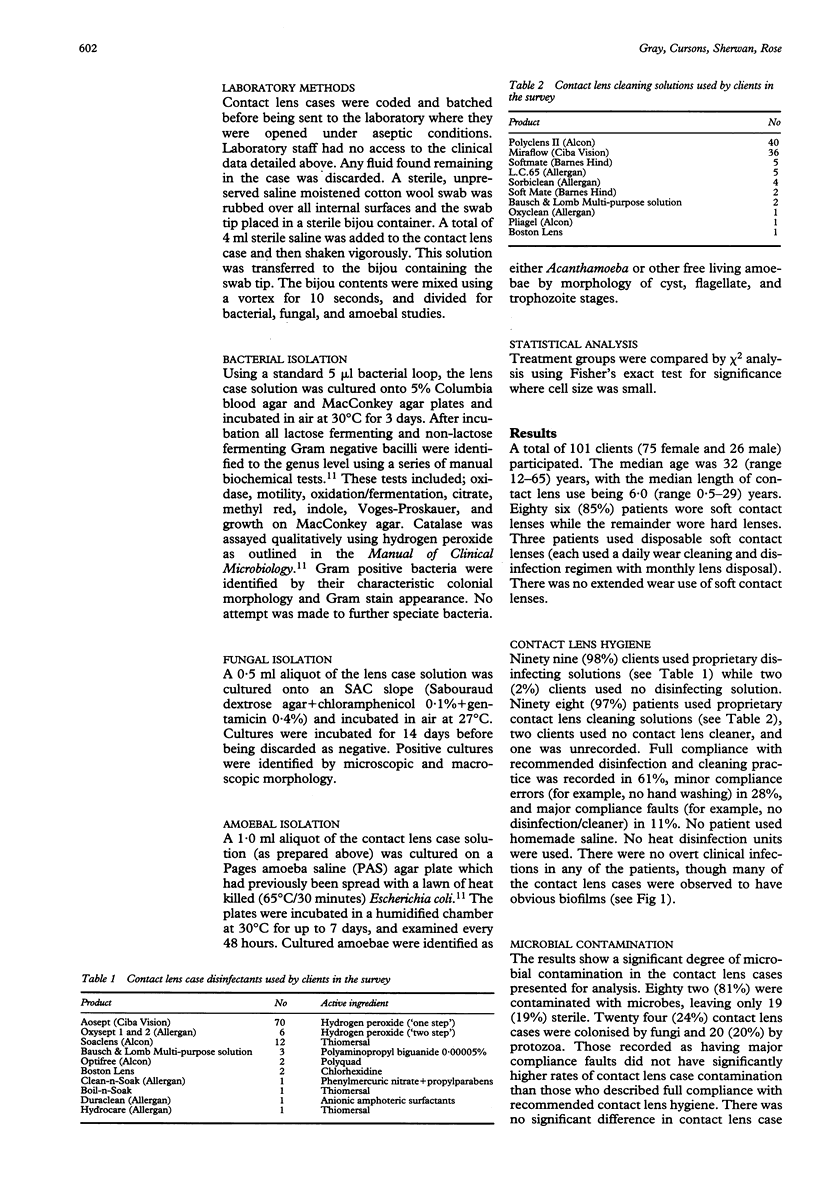
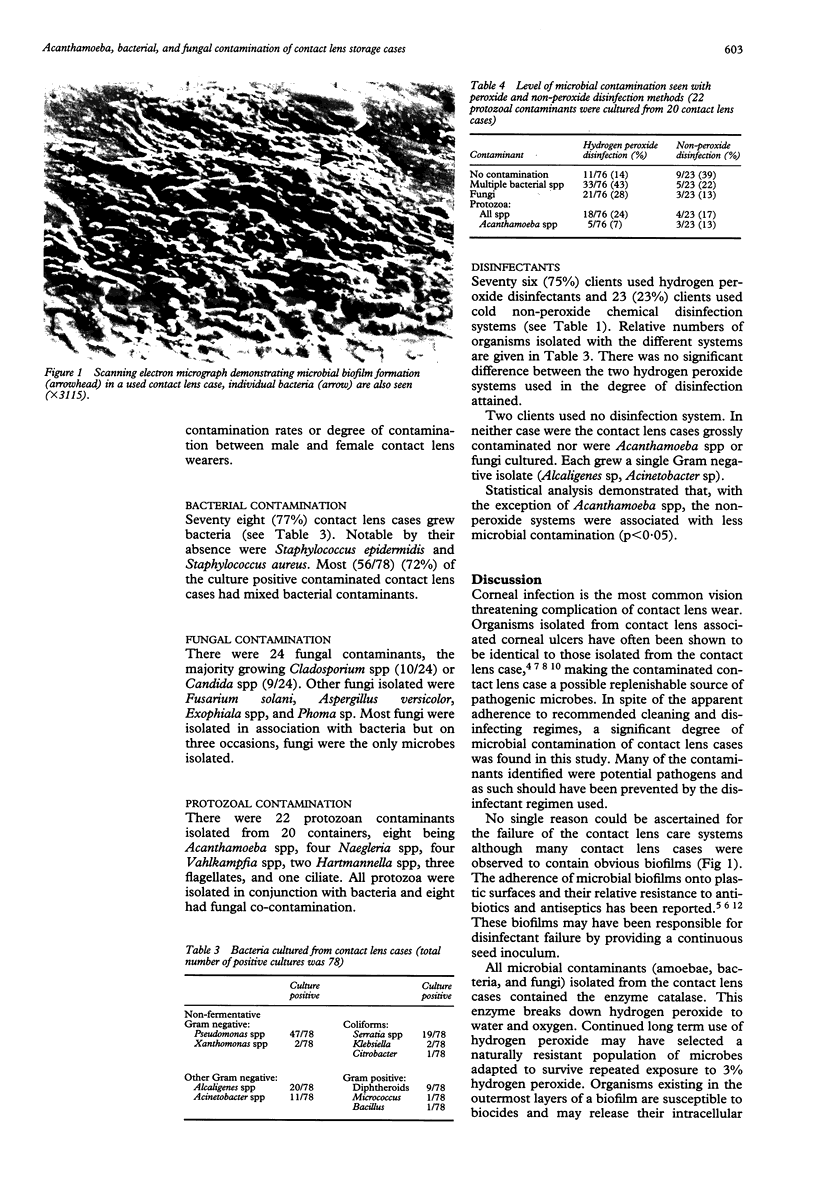
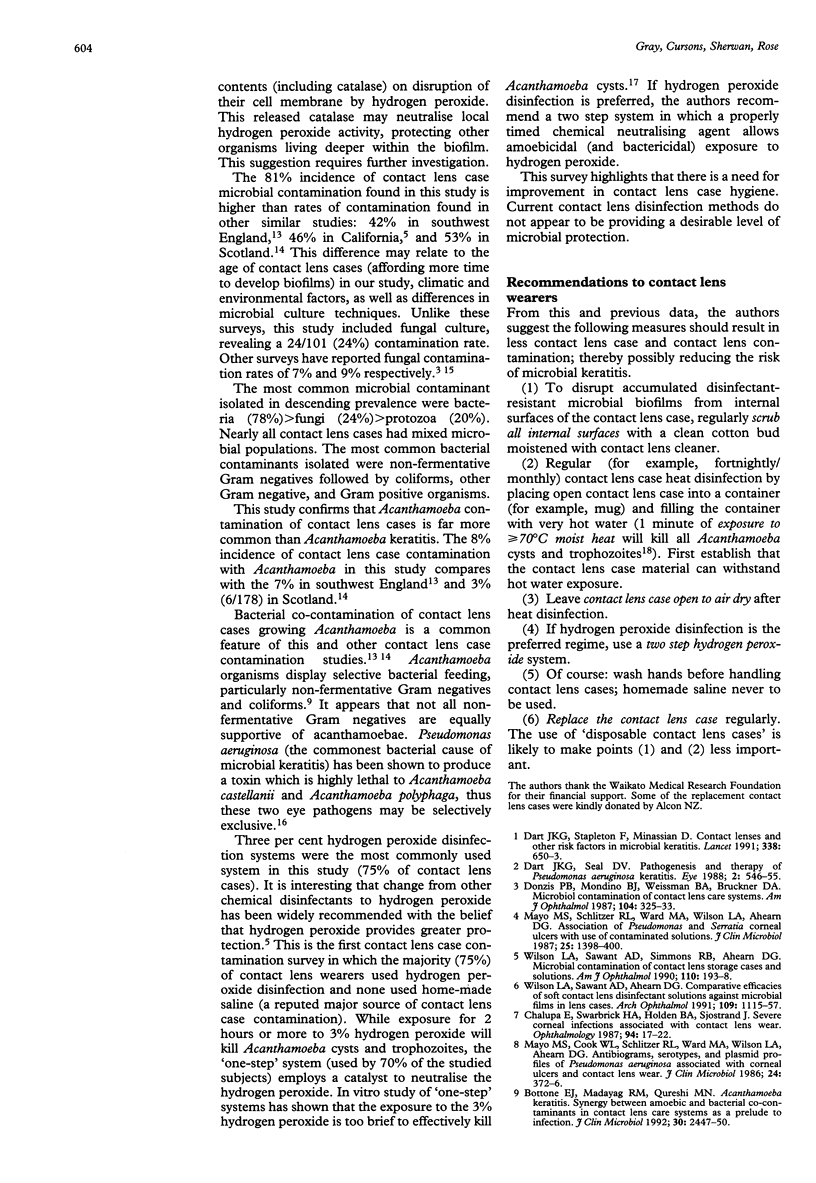
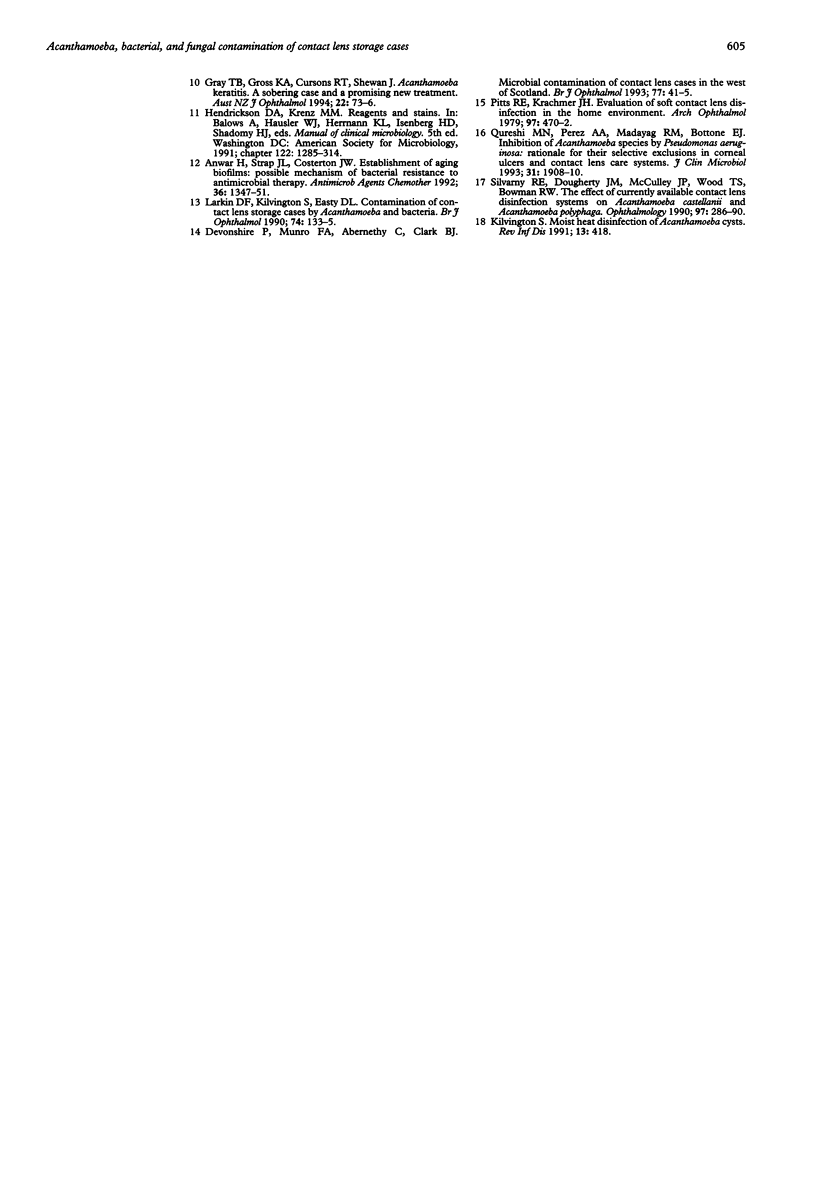
Images in this article
Selected References
These references are in PubMed. This may not be the complete list of references from this article.
- Anwar H., Strap J. L., Costerton J. W. Establishment of aging biofilms: possible mechanism of bacterial resistance to antimicrobial therapy. Antimicrob Agents Chemother. 1992 Jul;36(7):1347–1351. doi: 10.1128/aac.36.7.1347. [DOI] [PMC free article] [PubMed] [Google Scholar]
- Bottone E. J., Madayag R. M., Qureshi M. N. Acanthamoeba keratitis: synergy between amebic and bacterial cocontaminants in contact lens care systems as a prelude to infection. J Clin Microbiol. 1992 Sep;30(9):2447–2450. doi: 10.1128/jcm.30.9.2447-2450.1992. [DOI] [PMC free article] [PubMed] [Google Scholar]
- Chalupa E., Swarbrick H. A., Holden B. A., Sjöstrand J. Severe corneal infections associated with contact lens wear. Ophthalmology. 1987 Jan;94(1):17–22. doi: 10.1016/s0161-6420(87)33513-4. [DOI] [PubMed] [Google Scholar]
- Dart J. K., Stapleton F., Minassian D. Contact lenses and other risk factors in microbial keratitis. Lancet. 1991 Sep 14;338(8768):650–653. doi: 10.1016/0140-6736(91)91231-i. [DOI] [PubMed] [Google Scholar]
- Devonshire P., Munro F. A., Abernethy C., Clark B. J. Microbial contamination of contact lens cases in the west of Scotland. Br J Ophthalmol. 1993 Jan;77(1):41–45. doi: 10.1136/bjo.77.1.41. [DOI] [PMC free article] [PubMed] [Google Scholar]
- Donzis P. B., Mondino B. J., Weissman B. A., Bruckner D. A. Microbial contamination of contact lens care systems. Am J Ophthalmol. 1987 Oct 15;104(4):325–333. doi: 10.1016/0002-9394(87)90219-4. [DOI] [PubMed] [Google Scholar]
- Gray T. B., Gross K. A., Cursons R. T., Shewan J. F. Acanthamoeba keratitis: a sobering case and a promising new treatment. Aust N Z J Ophthalmol. 1994 Feb;22(1):73–76. doi: 10.1111/j.1442-9071.1994.tb01700.x. [DOI] [PubMed] [Google Scholar]
- Larkin D. F., Kilvington S., Easty D. L. Contamination of contact lens storage cases by Acanthamoeba and bacteria. Br J Ophthalmol. 1990 Mar;74(3):133–135. doi: 10.1136/bjo.74.3.133. [DOI] [PMC free article] [PubMed] [Google Scholar]
- Mayo M. S., Cook W. L., Schlitzer R. L., Ward M. A., Wilson L. A., Ahearn D. G. Antibiograms, serotypes, and plasmid profiles of Pseudomonas aeruginosa associated with corneal ulcers and contact lens wear. J Clin Microbiol. 1986 Sep;24(3):372–376. doi: 10.1128/jcm.24.3.372-376.1986. [DOI] [PMC free article] [PubMed] [Google Scholar]
- Mayo M. S., Schlitzer R. L., Ward M. A., Wilson L. A., Ahearn D. G. Association of Pseudomonas and Serratia corneal ulcers with use of contaminated solutions. J Clin Microbiol. 1987 Aug;25(8):1398–1400. doi: 10.1128/jcm.25.8.1398-1400.1987. [DOI] [PMC free article] [PubMed] [Google Scholar]
- Pitts R. E., Krachmer J. H. Evaluation of soft contact lens disinfection in the home environment. Arch Ophthalmol. 1979 Mar;97(3):470–472. doi: 10.1001/archopht.1979.01020010220005. [DOI] [PubMed] [Google Scholar]
- Qureshi M. N., Perez A. A., 2nd, Madayag R. M., Bottone E. J. Inhibition of Acanthamoeba species by Pseudomonas aeruginosa: rationale for their selective exclusion in corneal ulcers and contact lens care systems. J Clin Microbiol. 1993 Jul;31(7):1908–1910. doi: 10.1128/jcm.31.7.1908-1910.1993. [DOI] [PMC free article] [PubMed] [Google Scholar]
- Shahidi M., Ogura Y., Blair N. P., Rusin M. M., Zeimer R. Retinal thickness analysis for quantitative assessment of diabetic macular edema. Arch Ophthalmol. 1991 Aug;109(8):1115–1119. doi: 10.1001/archopht.1991.01080080075032. [DOI] [PubMed] [Google Scholar]
- Silvany R. E., Dougherty J. M., McCulley J. P., Wood T. S., Bowman R. W., Moore M. B. The effect of currently available contact lens disinfection systems on Acanthamoeba castellanii and Acanthamoeba polyphaga. Ophthalmology. 1990 Mar;97(3):286–290. doi: 10.1016/s0161-6420(90)32590-3. [DOI] [PubMed] [Google Scholar]
- Wilson L. A., Sawant A. D., Simmons R. B., Ahearn D. G. Microbial contamination of contact lens storage cases and solutions. Am J Ophthalmol. 1990 Aug 15;110(2):193–198. doi: 10.1016/s0002-9394(14)76991-0. [DOI] [PubMed] [Google Scholar]



